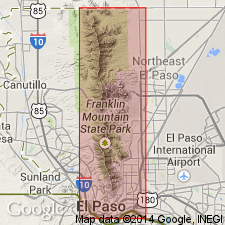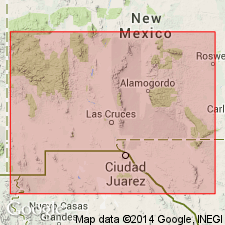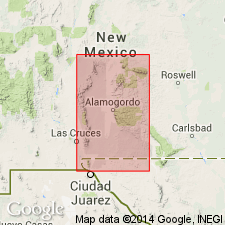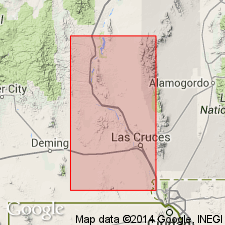
- Usage in publication:
-
- Canutillo formation
- Modifications:
-
- Areal extent
- AAPG geologic province:
-
- Orogrande basin
Summary:
Pg. 89. Stratigraphic section in Franklin Mountains [Texas] includes Devonian Canutillo formation which lies between Mississippian Helms formation and Silurian Fusselman limestone.
See also University of Colorado Bulletin, v. 32, no. 17, p. 89.
Source: US geologic names lexicon (USGS Bull. 1200, p. 614-615).

- Usage in publication:
-
- Canutillo formation
- Modifications:
-
- First used
- Dominant lithology:
-
- Shale
- Limestone
- Sandstone
- AAPG geologic province:
-
- Orogrande basin
Summary:
Canutillo formation. First published use of name [first mentioned in 1937 in a thesis by the author, in University of Colorado Bulletin, v. 32, no. 17, p. 89]. In Franklin Mountains consists of about 175 feet of (ascending): (1) cherty limestone, light-brown in color, immediately overlying Fusselman; (2) thin beds of fossiliferous gray limestone; (3) thin bed of dense, almost black sandstone, which weathers brown; and (4) about 40 feet of black, fissile shale at top of formation. "Darton [1929] and others reported this as Upper Devonian (Percha) in age, but Kirk [personal communication from Dr. Girty] identified it as Middle Devonian. This equivalent probably occurs in the Hueco Mountains but it does not crop out beyond the northern end of the Franklin Mountains or in the western part of the area. Since this formation was at first thought to be the Percha equivalent and later was classified as Middle Devonian with no formational name given to it, the writer has proposed that it be called the Canutillo formation." Shown on correlation chart as everywhere overlying the Middle Silurian Fusselman limestone, and, in Franklin Mountains, underlying the Upper Mississippian Helms formation. Age is Middle Devonian. Report includes stratigraphic chart.
Type locality not designated. Named from town of Canutillo, on the Santa Fe RR about 13 mi north of El Paso, El Paso Co., TX, Orogrande basin.
Source: GNU records (USGS DDS-6; Denver GNULEX); supplemental information from US geologic names lexicon (USGS Bull. 1200, p. 614-615).

- Usage in publication:
-
- Canutillo formation
- Modifications:
-
- Areal extent
- AAPG geologic province:
-
- Orogrande basin
Summary:
Pg. 22-23. Canutillo formation. Most limited in areal extent of all Devonian formations in New Mexico. Basal part consists chiefly of massive calcareous siltstone that is overlain by thin beds of varicolored shale interbedded with massive thick beds of calcareous brown siltstone. Average thickness 25 to 30 feet. Most complete exposure, 88 feet thick, is in San Andres Canyon, San Andres Mountains. Overlies Fusselman limestone; underlies Sly Gap formation. Fauna and geologic history of southwest indicate that formation is probably early Late Devonian.
Source: US geologic names lexicon (USGS Bull. 1200, p. 614-615).

- Usage in publication:
-
- Canutillo formation
- Modifications:
-
- Areal extent
- AAPG geologic province:
-
- Orogrande basin
Stevenson, F.V., 1945, Devonian of New Mexico: Journal of Geology, v. 53, no. 4, p. 217-245.
Summary:
Canutillo formation. Geographically restricted to the Franklin Mountains, El Paso County, Texas. In the Sacramento Mountains, central Otero County, and San Andres Mountains, Dona Ana County, New Mexico (Orogrande basin), rocks beneath the Sly Gap formation that were previously assigned to the Canutillo (from supposed correlation with Canutillo of Franklin Mountains) are herein named the Onate formation. Sly Gap and Canutillo may be time equivalents. Faunal collections (large plant remains) from the upper Canutillo in the Franklin Mountains were not diagnostic beyond medial Devonian; these deposits are thought to be of near-shore, possibly brackish water origin. Report includes correlation chart.
Source: US geologic names lexicon (USGS Bull. 1200, p. 614-615); supplemental information from GNU records (USGS DDS-6; Denver GNULEX).

- Usage in publication:
-
- Canutillo formation
- Modifications:
-
- Overview
- AAPG geologic province:
-
- Orogrande basin
Summary:
Pg. 36, 37 (fig. 17). In Franklin Mountains, Texas, formation consists of approximately 15 feet of soft thin-bedded gray siltstone. Separated from underlying Fusselman by 42 feet of cherty limestone, probably Devonian; overlain by 57 feet of soft flaky gray-black shale identical in character with part of Percha shale of Lake Valley area.
Source: US geologic names lexicon (USGS Bull. 1200, p. 614-615).
For more information, please contact Nancy Stamm, Geologic Names Committee Secretary.
Asterisk (*) indicates published by U.S. Geological Survey authors.
"No current usage" (†) implies that a name has been abandoned or has fallen into disuse. Former usage and, if known, replacement name given in parentheses ( ).
Slash (/) indicates name conflicts with nomenclatural guidelines (CSN, 1933; ACSN, 1961, 1970; NACSN, 1983, 2005, 2021). May be explained within brackets ([ ]).

